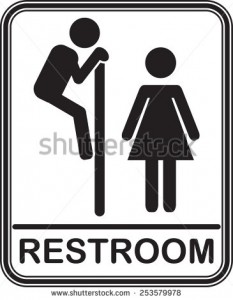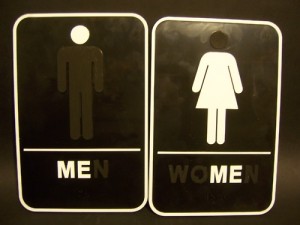
Public restrooms are often places where we feel the most vulnerable outside the comfort of our homes, because like Bazelon explains it a place where “we undress and obey the dictates of our bodies” (1). Subsequently, if a man walks into a women restroom or vice versa it would make the dominant gender occupying the space feel uncomfortable.
Bazelon explains how this discomfort is the driving force for things like the rejection of The Broad of Equal Rights ordinance in Texas. The ordinance would have protected against discrimination based on age, race, and sexual orientation, but opponents were too scared of sharing a bathroom with the opponent sex to accept it. Many institutions are facing the same problem of deciding whether or not to allow unisex bathrooms or bathroom accommodations.
Schools face this issue with transgender individuals who want to use the bathroom and locker rooms of the gender they identify to. Bazelon uses an example of a transgender teen in Illinois to example the issue. The teen wanted to use the same facilities as all the other girls but was sent to a separate area to change and use the restroom. The case was sent to the States Department of education who decided to intervene and let her use the facilities as long as she had a privacy curtain.
In that case they did a good job at accommodating that student. Accommodation is to basically come to a middle ground and agreement on a situation that benefits everyone. Accommodation can be seen in US history from in the 60’s with accommodation for religious people at work and in the with those with disability (4).Though accommodating in restrooms is a fairly recent thing the separation of bathroom isn’t a new phenomenon it dates back to the Victorian era. But it wasn’t until the 19 century that states started to require gender exclusive water closets. They were created to give women a place to rest so they wouldn’t faint being that they were seen as weaker than men.

Today women’s restrooms verse men’s are “refined and gentle” which give women a safe haven to relax and chat with friends. The author suggest that women have become attached to this comfort and this is why events like the rejection of the accommodation law in Texas happen.
Though many people fear it accommodation is a vital part of the society that we live in. What Bazelon is trying to point out is that we shouldn’t only accommodate for the easy things or more practical things we should accommodate for everyone. She says for those with disabilities it is a reasonable accommodation to put a bar next to a toilet or a button that opens a door, but for a transgender kid showering near peers in your own stall and changing behind a curtain is just as reasonable (11). When put that simply it is hard to justify the denial of accommodation transgender youth and restrooms in general.

Bazelon does a wonderful job of laying out the subject of unisex bathrooms, and explaining the key issues by tying it all together with the concept of accommodation.
Bibliography
BAZELON, EMILY. “Making Bathrooms More Accommodating.” New York Times Magazine. 17 November 2015. Web. 2 January 2016.



